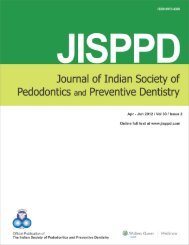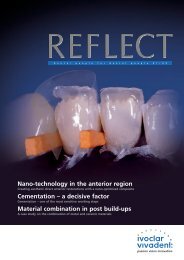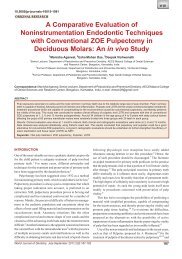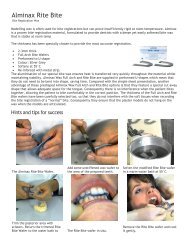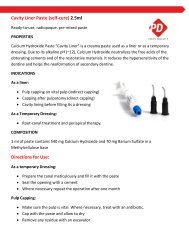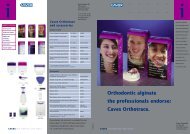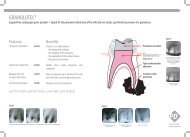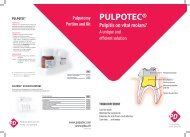Clinical Evaluations
Clinical Evaluations - Universal Dental - universaldental.com.pk
Clinical Evaluations - Universal Dental - universaldental.com.pk
- No tags were found...
Create successful ePaper yourself
Turn your PDF publications into a flip-book with our unique Google optimized e-Paper software.
<strong>Clinical</strong> <strong>Evaluations</strong><br />
1. FINAL REPORT OF CLINICAL TRIALS OF PULPOTEC<br />
(TRANSLATION OF THE ORIGINAL FRENCH TEXT)<br />
2. S.A. DEDEYAN, I.P. DONKAYA. USE OF "PULPOTEC" FOR TREATMENT OF<br />
ODONTITIS IN PEDIATRICS.<br />
HEAD OF PEDIATRICS THERAPEUTIC DENTISTRY<br />
CENTRAL RESEARCH INSTITUTE OF STOMATOLOGY / MOSCOW<br />
(TRANSLATION OF THE ORIGINAL RUSSIAN TEXT)<br />
3. TREATMENT OF THE MULTIROOTED TEETH PULPITIS BY THE<br />
AMPUTATION METHOD USING "PULPOTEC" (PD, SWITZERLAND)<br />
S. MELEKHOV, O. KAPIRULINA, N. YAKUSH, A. LYASHENKO<br />
CHAIR OF THE THERAPEUTIC STOMATOLOGY, KUBANSKAYA MEDICAL<br />
ACADEMY (KRASNODAR)<br />
(TRANSLATION OF THE ORIGINAL TEXT)<br />
1. FINAL REPORT OF CLINICAL TRIALS OF<br />
PULPOTEC<br />
(TRANSLATION OF THE ORIGINAL FRENCH TEXT)<br />
1. Synopsis :<br />
Following 17 years of utilization of the Pulpotec Filling Paste on approximately 3’000<br />
permanent and temporary molars with a clinical success rate of 80%, it would appear<br />
that the advantages offered by its utilization are clearly superior to any inconveniences,<br />
which are only minor, under normal conditions of use.<br />
2. Introduction :<br />
It was following an apical leak during a technique of total pulpectomy carried out about<br />
15 years ago on an inferior molar, which was developing in a worrying fashion, that the<br />
idea was born of updating pulpotomy. This had already been proposed by A. Marmasse,<br />
Professor at the Paris Dental School a few years previously.<br />
The usual treatment applied to pulpitis on a living tooth involves removing the totality of<br />
the pulp in the treated tooth and filling the cavity with an obturating material like an<br />
antiseptic paste, based on Zinc Oxide and Eugenol, or a paste based on Bakelite or<br />
condensed Gutta. This type of operation, when practiced on a molar, proves to be long<br />
and complicated due to the complexity of the shape of the roots, the narrowness of the<br />
buccal cavity and the difficulty of inducing total anesthesia in mandibular molars in
particular.<br />
In this sense, recent studies (1) have shown that the failure rates of endodontic<br />
treatments by pulpectomy are over 50% throughout the world, including Switzerland,<br />
Sweden and the U.S.A. These failures are characterized by an infection which starts at<br />
the extremity of the root. One must then imperatively have access to the roots of the<br />
tooth in order to repeat the treatment. This is not always easy due to the fact that any<br />
paste for canals, in particular Bakelite, is particularly difficult to remove. If the tooth<br />
cannot be treated again, it will have to be extracted. In addition, studies concerning the<br />
anatomy of the radicular canals (2) have shown that these contain numerous branches<br />
which cannot be reached during a total pulpectomy.<br />
In addition, the practice of pulpectomy is accompanied by numerous risks like the<br />
inhaling by the patient of canal instruments used to extract the nerve from its cavity or<br />
the penetration of obturating material beneath the roots. In this latter case, the<br />
complications can be extremely serious, since they range from fungal sinusitis of the<br />
upper maxillary (3) to the onset of permanent pain in the lower maxillary for which no<br />
therapy currently exists (4-5).<br />
At one time, the practice of pulpotomy was considered to be an alternative to<br />
pulpectomy. Rather than remove the totality of the pulp in a tooth, the dental surgeon<br />
performed a selective amputation in the coronal part of the tooth pulp contained in the<br />
pulpal chamber, and then sealed the cavity with a classical sealing material.<br />
Pulpotomy presents numerous advantages when compared with pulpectomy (8).<br />
Amongst these, one can mention significant time saving, easy access to the part of the<br />
pulp which is to be treated and simplified technical procedures for the practitioner. The<br />
combination of these factors means that the principal risks which accompany<br />
pulpectomy are eliminated, in particular those linked with the use of canal instruments<br />
and to the leakage of filling material beneath the roots.<br />
Nevertheless, the obturating materials used to date for pulpotomy have not been<br />
satisfactory, as they have caused cases of degeneration and infection in the residual pulp.<br />
Consequently, due to the numerous difficulties based on the inadequacy of the<br />
obturating material used, the practice of pulpotomy has been abandoned, despite its<br />
indisputable advantages. It should also be noted that pulpotomy is the only technique<br />
which authorizes complete radicular edification of immature permanent molars.<br />
Recent studies (6), taking into account the observations of Professor A. Marmasse on<br />
pulpotomy (7), have revealed that the pulp has a great capacity for healing. This has led<br />
us to investigate the possibilities of perfecting a filling material capable of compensating<br />
for the inconveniences mentioned above and also generating the cicatrisation of the<br />
radicular pulp and its perenniality with the help of substances which would initially<br />
ensure antisepsis and hemostasis and then the maintenance of long term antisepsis and<br />
impermeability by means of a good volumetric stability.<br />
3. Treatment :<br />
In 1989 it was decided (after having treated a few cases in 1987) to treat all the<br />
permanent and temporary molars of the patients exhibiting pulpitis on a vital tooth by
pulpotomy, being convinced that the risks incurred were much less important than those<br />
linked to a pulpectomy, a failure implying, in the majority of the cases, a simple return<br />
to treatment by so -called total pulpectomy.<br />
Pulpotomy consists in amputating the cameral pulp and then capping the pulpal stumps<br />
with an obturating paste. To do this, the ceiling of the pulpal chamber should be<br />
removed by means of a Zekrya surgical bur, then the cameral pulp should be removed<br />
with a Zekrya Endo type bur. The pulpal chamber should be re-shaped with a pearshaped<br />
diamond bur. It is important to use high speed rotary instruments in order to<br />
avoid tearing the radicular fibres, which must imperatively remain in the canals.<br />
The pulpotomy as such is completed by placing Pulpotec in the cavity chamber by<br />
means of a rotary Paste Filler of large diameter. The Pulpotec is then covered with a<br />
temporary dressing. A cotton roll should then be inserted between the two arches and<br />
the patient requested to bite firmly so that the Pulpotec adheres closely to the walls of<br />
the pulpal chamber and the openings of the radicular canals, thereby ensuring perfect<br />
impermeability.<br />
During a second session, approximately 8 days later, a permanent filling should be<br />
placed and followed, where necessary, by the placement of a crown prosthesis.<br />
4. <strong>Clinical</strong> investigation :<br />
To date approximately 3’000 teeth have been treated, half of which were permanent and<br />
the other half temporary.<br />
An initial X-ray was taken on the day of treatment by pulpotomy and then, after the<br />
first 3 years, each time the patient returned to the practice. (The X-ray follow-up was<br />
carried out for permanent teeth only).<br />
To this day, 310 radiological cases have been followed for periods between 3 and 13<br />
years (3 years : 48 teeth; 4 years : 54 teeth; 5 years : 50 teeth; 6 years : 26 teeth; 7 years :<br />
20 teeth; 8 years : 26 teeth; 9 years : 36 teeth; 10 years : 21 teeth; 11 years : 17 teeth; 12<br />
years : 8 teeth; 13 years : 6 teeth; 15 years : 1 tooth). When analyzing the results, the<br />
absence of pain for a long period was also taken into consideration as well as the<br />
efficiency of mastication.<br />
In the majority of cases concerning permanent teeth, a crown prosthesis was placed in<br />
order to ensure the best possible tightness of the filling. In addition, it should be noted<br />
that this prosthesis also acts as an “early-warning device” because, given its cost, the<br />
patient will not hesitate to come for a consultation in case of pain and pain could<br />
indicate an infection of the radicular system.<br />
5. Results :<br />
5.1) Deciduous teeth :<br />
Immediate pain relief after treatment in 80% of cases; mild pain which lasts only 2 to 3<br />
days in 20% of cases. These teeth are clinically mute and function until they disappear<br />
from the dental arch to give way to the permanent teeth which follow them. This is the
case for deciduous teeth which have remained in place until their “natural” elimination.<br />
It should be noted that some 30% of generally uncrowned temporary teeth, fracture<br />
during mastication and have to be extracted by the practioner. In this case, treatment by<br />
Pulpotec is, obviously, not at fault.<br />
5.2) Permanent teeth :<br />
a) The 310 cases X-rayed present a healthy physiological image with no trace of<br />
periapical infection in the second X-ray, added to which, these teeth were not painful<br />
and mastication was perfectly normal.<br />
During the same period of 13 years, 61 permanent teeth had to undergo further<br />
treatment by total pulpectomy. It seems logical to be able to compare these two figures.<br />
Effectively, in both cases, it is impossible to follow all the patients treated. This suggests<br />
a success rate of 80%, a figure which also corresponds to that quoted by Professor A.<br />
Marmasse in his work (7).<br />
b) Undesirable side-effects :<br />
Following utilization of Pulpotec, 3 types of undesirable side-effects have been noticed :<br />
> In 15% of the cases of teeth treated, a more or less intense pain of an arthritic type<br />
was felt during the days which followed the treatment. It lessened progressively on its<br />
own or with the help of anti-inflammatory medication taken orally to speed up the<br />
process.<br />
> In 3% of the cases of teeth treated, pain of medium intensity (also quoted by Professor<br />
Marmasse) was felt until the second session 8 days later. This was treated by the<br />
immediate removal of the Pulpotec from the pulpal chamber, followed by the placement<br />
of a new dose of Pulpotec. Pain ceased immediately in each case.<br />
> Exceptionally (2 cases in this study) pain of high intensity can occur. This was due to<br />
the fracture of a tooth which had not been detected during the initial examination or to<br />
the perforation of the floor of the pulpal chamber which had also been overlooked. In<br />
such cases the tooth most often has to be extracted which is precisely the same<br />
consequence which would have prevailed following treatment by pulpectomy.<br />
6. Discussion and conclusions :<br />
Obviously, it is difficult to expect that X-rays and a clinical follow-up alone will prove<br />
the perenniality of pulpal vitality after treatment with Pulpotec.<br />
Proof of this type, stated by Dr Marmasse to be very difficult to establish after vital<br />
pulpotomy (7), has not been included in these clinical trials for both ethical and practical<br />
reasons.<br />
On the other hand, post-operative functional tests, as well as the X-rays, appear to<br />
confirm the perenniality of pulpal vitality after treatment with Pulpotec.
This is further confirmed by the fact that the follow-up of immature permanent molars<br />
treated with Pulpotec, has indicated normal, progressive radicular edification until<br />
complete maturity.<br />
Finally, if one considers that, on the one hand, in addition to the important risks linked<br />
to periapex, the further risks linked to pulpectomy are (with the exception of point N° 2)<br />
identical to those linked to pulpotomy, that is to say essentially pain of an arthritic type<br />
and, on the other hand, the percentage of clinical failure is significantly higher for<br />
pulpectomy than for pulpotomy (50% versus 20%), it would seem sensible to prefer this<br />
technique. All the more so as it grants an additional span of life for the tooth and<br />
simplifies the work of the dental surgeon. As a result, it can be considered more reliable<br />
and likely to optimize the chances of survival for the teeth treated by pulpotomy with<br />
Pulpotec.<br />
The investigator :<br />
Dr J. B.<br />
Dental-surgeon<br />
Bibliography<br />
1. L’information Dentaire N° 44 of 19 December 1996-3535 article entitled<br />
“Restarting treatment in endodontics”<br />
2. L’information Dentaire N° 33 of 28 September 1995 (work by Hess-1925-,<br />
De Deus - 1975- and Vertucci - 1984 -)<br />
3. Actualités odonto-stomatologiques N° 192 December 1995 - 563 -<br />
4. L’information dentaire N° 25 of 22nd June 1972, Article by Pr<br />
Commissionnat : «The flow-back in the lower dental canal of filling substances<br />
constitutes a major urgencyin our specialty»<br />
5. L’information Dentaire N° 40 of 21 November 1996 Article by Claude<br />
Aaron and Yves Commissionnat<br />
6. Swedish Dental Journal supplement 39, 1986 : Dental Pulp Inflammation,<br />
experimental studies in human and monkey teeth by Johan Warfvinge<br />
7. Dentisterie Opératoire, Volume 1, Dentisterie Thérapeutique, Professor A.<br />
Marmasse 1969<br />
8. Hess J.C., Medioni E. et Vene G. : “ Thérapeutique endodontique. Ensemble<br />
pulpo-dentinaire. Pulpotomie ” - Editions techniques – Encycl. Méd. Chir.<br />
(Paris-France) Odontologie 23035 D18, 2 –1990.
9. Pediatr Dent 2001 Jul-Aug; 23(4): 331-6, "Outcome of formocresol/ZOE<br />
sub-base pulpotomies utilizing alternative radiographic success criteria.<br />
Strange DM, Seal NS, Nunn ME, Strange M."<br />
January 15th 2002<br />
APPROVED<br />
Director of the Central research Institute<br />
of Stomatology, Corresponding Member<br />
of the Russian Academy of Medical Sciences,<br />
professor V.M. Bezroukov<br />
October 10, 2003<br />
2. S.A. DEDEYAN, I.P. DONKAYA. USE OF<br />
"PULPOTEC" FOR TREATMENT OF ODONTITIS IN<br />
PEDIATRICS.<br />
HEAD OF PEDIATRICS THERAPEUTIC DENTISTRY<br />
CENTRAL RESEARCH INSTITUTE OF<br />
STOMATOLOGY / MOSCOW<br />
(TRANSLATION OF THE ORIGINAL RUSSIAN TEXT)<br />
Medical testing of the preparation for treatment of the caries aftereffects ‘Pulpotec’ was<br />
provided in the in-patient unit of the children’s therapeutic stomatology of the Central<br />
research Institute of Stomatology from April till October, 2003. <strong>Clinical</strong> trials were run<br />
due to agreement with the company ‘Valleks M’ that provided ‘Pulpotec’ in standard<br />
packing containing 30 g of powder and 15 mg of liquid of the following solution:<br />
Powder: polyoxymethene, iodoform, zinc;<br />
Liquid: dexamethasone, formaldehyde, phenol, guaiacol and subsidiary substances.<br />
Documents provided by the company (toxicological and clinical trials logs from the<br />
foreign clinics, scientific articles) contain summary for 13 years lasting experience of<br />
successful use of the preparation for treatment of the caries aftereffects.<br />
The main indication for use of ‘Pulpotec’ is treatment of odontitis in temporary and<br />
permanent teeth of children with keeping of viable root pulp. The problem is not solved<br />
till now due to uncertain results of use of preparations based on calcium hydrate,<br />
eugenol paste, glutaronic aldehyde, etc. in vital amputation method. Viable pulp in root<br />
canals serves as safe barrier for germ intrusion into periapical tissues preventing from<br />
development of dental infection. Infection of tissues surrounding roots of the temporary<br />
tooth makes a big danger for rudiments of permanent teeth as may tend to violation in
the normal development even to loss.<br />
Keeping of children’s pulp viable in temporary teeth with incomplete development of<br />
roots is the most actual thing because only at the condition of the normal functioning of<br />
the root pulp the final development of a root, closing of the apical opening and<br />
development of the valuable peridental membrane are possible.<br />
Dentists deal with the need of the vital amputation in the adult practice at treatment of<br />
molars quite often, especially it refers to treatment of wisdom teeth having canals of the<br />
complex shape and inaccessible for valuable root canal treatment with difficult access.<br />
They do not possess materials meeting all demands in full for vital amputation of pulp<br />
till now. The preparation used shall provide haemostatic, anesthetic, antiphlogistic and<br />
long-term antiseptic state of pulp’s stump and its hermetic closing.<br />
The clinic trials of ‘Pulpotec’ provided were aimed at estimation of its effectiveness and<br />
tolerance by patients, detection of possible complications during the process of<br />
treatment, in the nearest time afterwards and dynamic observation up to 6 months with<br />
X-ray control at stages of the treatment.<br />
42 patients, male and female, ages from 4 to 56 years have taken part in clinical trials.<br />
Treatment of odontitis in molars by method of vital amputation was provided. Children<br />
in the age 4-6 years have made the biggest group of 30 persons with ‘Pulpotec’ used for<br />
treatment of odontitis in temporary molars. 7 kids in the age of 8-10 years have made<br />
the second group with preparation used for treatment of permanent molars with<br />
incomplete development of roots. 5 persons with dystopic third molars and difficult<br />
access to root canals.<br />
Evidence of individual sensitivity to ‘Pulpotec’ ingredients uncovered by data of<br />
anamnesis collected was considered to be the contra-indication to participation in trials.<br />
All patients were recruited for trials only with the evidence of their autographic written<br />
consent or consent of their plenipotentiary (Amendment #1). To provide such a consent<br />
they were supplied by irrefragable explanation from the medical doctor on aims and<br />
duration of the research work, method of use of the preparation, possible discomfort<br />
and adverse effects. Patients were given the possibility to ask questions on any aspects of<br />
the research work and refuse to participate at any time without any explanations and<br />
consequences.<br />
After receiving of deliberate consent for treatment the patient was sent for X-ray trial in<br />
order to verify the state of periapical tissues nearby the tooth to be treated.<br />
Treatment of odontitis by method of vital amputation was provided in two visits. During<br />
the first visit the carious cavity was prepared after anesthetization, the tooth cavity was<br />
lanced and opened by the sterile bur and amputation and thorough hemostasis (with the<br />
help of ‘Catalugel’ preparation) were provided by the sterile sharp spherical dental<br />
drill. Wad of cotton wool moistened in the solution of the preparation was put onto the<br />
mouth of canals for 2-3 minutes to provide hemostasis. The procedure was repeated<br />
upon necessity. After the stanching a portion of ‘Pulpotec’ mixed to crème-like<br />
consistence was deposited over the stump of the pulp. Tooth cavity was closed by the
temporary cement ‘PD’ in paste. In order to provide good adjacency of the paste to<br />
canal sides and mouth the wad of cotton wool was placed between the upper and lower<br />
molars. The patient was asked to bite it slightly at first and then stronger. The<br />
temporary inlay and preparation were removed during the second visit after 8-10 days,<br />
the fresh portion of ‘Pulpotec’ of denser consistence was deposited into the tooth cavity<br />
and the final sealing was provided. X-ray trials were run before and 6 months after the<br />
treatment to observe dynamics of the process of treatment.<br />
Thorough stanching before depositing of the preparation to avoid blood clot that may<br />
prevent from access of the preparation to the stump of the pulp and tend to<br />
complications upon evidence of infection was the matter of the special attention.<br />
Easiness and simplicity of use of ‘Pulpotec’ were ascertained during the medical trials.<br />
The paste hardens quickly after mixing of ingredients that preventing isolation of<br />
volatile fractions, providing optimal conditions for depositing of cavity liner and seal<br />
and decreasing the time for treatment radically. Preparation does not adhere to tools<br />
and does not strive after them, has good adhesion ability relatively tooth cavity sides. It<br />
is important to mention that uniform paste is produced after mixing of ingredients of the<br />
preparation having no pungent, foul smell and causing no negative reaction of the<br />
patient.<br />
<strong>Clinical</strong> trials provided have shown absence of pains at all patients without exception<br />
after use of ‘Pulpotec’. Even if the pain syndrome was found evident at diagnostics of<br />
odontitis it was completely arrested after depositing of the first portion of the<br />
preparation. No complaints were lodged by patients either in the intervals between visits<br />
to clinic or during the dynamic observation (from 4 to 6 months). No swelling of gum in<br />
the area of the treated tooth was detected during the given period, no evidence of a<br />
fistula and no mobility of a tooth. No signs of destruction of osseous tissue in periapical<br />
tissues were found at control X-ray observation of 14 teeth 6 months after the treatment.<br />
Let us use as example the case of treatment of odontitis (child aged 5) when the evidence<br />
of anti-inflammatory and analgesic action of ‘Pulpotec’ was complete. The patient<br />
Botchkareva T. (born 1998, file #88070) applied to the clinic with complaints for sharp<br />
pains in the area of the lower jam, left side, evidence of swell and pains at swallowing.<br />
Upon examination acute form of hyperemia and edema at diminishing fold in the area of<br />
the 74th tooth were found, acute morbidity of edema at diminishing fold, submaxillary<br />
lymphadenopathy and pains upon palpation. Acute odontitis of the 74th tooth with signs<br />
of periodontitis was diagnosed. Tooth cavity was opened under anesthesia, coronal pulp<br />
ablated, hemostasis with use of ‘Catalugel’ provided and liquid portion of ‘Pulpotec’<br />
was deposited over the stump of pulp and the tooth was temporary sealed. Sufficient<br />
decrease of edema and pains upon palpation of lymph nodes were observed during the<br />
examination next day, no pains were reported. After removal of the temporary seal a<br />
new portion of ‘Pulpotec’ was deposited into the tooth cavity and the tooth was<br />
permanently sealed. In this case we have deviated from the traditional scheme of<br />
treatment when the evidence of inflammation in peridental membrane serves contraindication<br />
for temporary sealing of teeth. According to the actual standard we should<br />
have made pulp amputation, leave a tampon with anti-inflammatory preparation in the<br />
tooth cavity and proceed with treatment by de-vitalization of pulp method after stopping<br />
of inflammation. Traditional treatment shall take 3-4 visits with pain symptoms kept<br />
during several days.
CONCLUSION.<br />
According to the clinical trials provided the high efficiency of ‘Pulpotec’ for treatment of<br />
odontitis in molars of temporary and permanent teeth by vital amputation method and<br />
absence of negative dynamics during 6 months of the observation were ascertained. The<br />
preparation surpasses in efficiency similar drugs being in possession of pediatric<br />
dentists. Simplicity in use, absence of pain symptoms during the treatment, decreasing<br />
of terms of treatment to two visits, keeping of pulp vital shall be considered to be<br />
advantages of the preparation. Positive results of medical trials of ‘Pulpotec’<br />
preparation enable to recommend it for use in extensive clinical practice.<br />
The following publications were prepared upon research studies provided:<br />
1. I.P. Donskaya, S.A. Dedeyan. Treatment of odontitis in pediatrics by method of vital<br />
amputation with use of ‘Pulpotec’. Transactions of the VIII Congress of the Dentists<br />
Association of Russia. Moscow, 2003, pp. 287-288 (Amendment #2).<br />
2. S.A. Dedeyan, I.P. Donskaya. Use of ‘Pulpotec’ for treatment of odontitis in<br />
pediatrics. (Delivered for publishing).<br />
Head of Pediatric Therapeutic Dentistry<br />
Department, Candidate M.S.<br />
S.A. Dedeyan<br />
3. TREATMENT OF THE MULTIROOTED TEETH<br />
PULPITIS BY THE AMPUTATION METHOD USING<br />
"PULPOTEC" (PD, SWITZERLAND)<br />
S. MELEKHOV, O. KAPIRULINA, N. YAKUSH, A.<br />
LYASHENKO<br />
CHAIR OF THE THERAPEUTIC STOMATOLOGY,<br />
KUBANSKAYA MEDICAL ACADEMY (KRASNODAR)<br />
(TRANSLATION OF THE ORIGINAL TEXT)<br />
Number of ailments related to the pulpitis is nowadays about 40% as illustrated by the<br />
stomatological practice (E. Borovsky and others, 2002). Currently the most commonly<br />
treatment method as to all forms of the pulpitis is a vital and devital extirpation. These<br />
methods offer some advantages but also having substantial shortcomings such as: need<br />
for a wide range of the expensive endodontic tools, possible tooling damage within a root<br />
channel, complications related to some under- or oversealing of the channel, labour<br />
intensiveness, duration and expensiveness of the treatment process. The extirpation<br />
alternative for the multirooted teeth pulpitis treatment may be coronal pulp amputation.<br />
This given method is old-known (A. Rybakov, V. Ivanov, 1980) although its usage is of
limited occurrence due to difficulties of creating aseptic conditions and encapsulated<br />
pulp stump within both treatment procedure and after permanent sealing, especially in<br />
the II class cavities by Black (J.C. Hess., 2002).<br />
The goal of this given work is to evaluate efficiency of the using the «Pulpotec» material<br />
(PD, Switzerland) for a multi-rooted teeth pulpitis treatment by amputation method.<br />
Investigation materials and methods. The amputation method of the pulpitis treatment<br />
has been used for 16 patients. Eighteen teeth (all molar ones) were cured. Twelve teeth<br />
(66,7%) have been characterised by carious cavity as per II class by Black, six teeth<br />
(33,3%) – as per I class respectively. The abovesaid teeth were cured by classical pulp<br />
amputation method. Upon pulpotomy and stoppage the bleeding a pulp stump has been<br />
covered with special paste made ex tempore of the Pulpotec powder and liquid material<br />
included in Pulpotec set.<br />
Above paste a layer of the non-eugenol temporary cement in paste («PD») was laid. This<br />
cement layer has been carefully condensed with cotton pellet in order to create<br />
encapsulated pulp stump. Such condensed area may be also established if patient bites a<br />
wad of cotton wool located between relevant cured tooth and its antagonist (as<br />
recommended by the manufacturer). In two-three days the permanent sealing was made<br />
while a temporary cement layer has not been removed completely and that cement layer<br />
facing a pulp stump served as some insulation seal. Special composites for chemical and<br />
photosensitive hardening were used as permanent sealing material. Prior to and after<br />
treatment procedure a pulp viability was determined by EOD. Immediately upon the<br />
treatment procedure a tooth radiography was made.<br />
Results. At the time of investigation the EOD parameters were within 25-45 mA<br />
featuring with 37±8 mA at average suggesting a pulp viability. The 15 patients' (83.3%)<br />
sensation of pain (syndrome) disap-peared immediately after treatment procedure and<br />
three patients (17.7%) referred to it the next day. As long-term effects (after 6 months)<br />
the pulp electroexcitability was reduced reliably (_
S. Minosyan, 50 y.o. The 48th tooth was<br />
inaccessible by endodontic tools.<br />
A. Grishin, 30 y.o. The 16th tooth's<br />
medial-cheek root top was curved.<br />
Y. Ioannis, 23 y.o. The 26th tooth<br />
immediately upon treatment procedure.<br />
Y. Ioannis, 23 y.o. The 26th tooth after six<br />
months' period upon treatment procedure<br />
Discussion upon results obtained<br />
It has been found that despite removal of the pulp crown portion a root pulp may be<br />
partly viable. At first glance this occurrence may be considered doubtful because of the<br />
mummification properties of the components, but we suggest a mummification process<br />
refers to the pulp mouth part which closely adjoins the Pulpotec layer while the apical<br />
portion remains viable enabling, in particular, the apical edification of the immature<br />
tooth.<br />
Literature<br />
1. E. Borovsky. Therapeutic Stomatology. M.: Medicine, 2002.<br />
2. A. Rybakov, V. Ivanov. <strong>Clinical</strong> therapeutic stomatology. M., 1980.<br />
3. Hess J.C., Medioni E., Vene G.. Thérapeutique endodontique. Ensemble pulpodentinaire.<br />
Pulpotomie //Encycl. Méd. Chir. Odontologie. – 2002. – N° 1.<br />
Click here to see the PDF version of the original article of Prof. Melekhov published in<br />
"The Dentistry Today" magazine.




